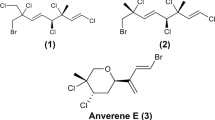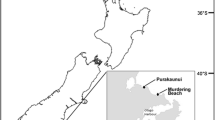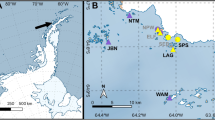Abstract
Apakaochtodenes A and B, which are halogenated monoterpenes and the major secondary metabolites in Portieria hornemannii, are effective feeding deterrents toward herbivorous reef fishes on Guam. A reciprocal transplant study was conducted to determine the relative importance of environmental versus genetic factors influencing site-to-site differences in the amount of apakaochtodenes produced. The study sites were chosen for characteristically high (Anae Island) and low (Gun Beach) apakaochtodene levels. Algae collected from Anae Island and Gun Beach differed significantly in concentrations of apakaochtodene B at the start of the experiment, but by the end they had almost the same amount of the metabolite because the level had decreased in plants at Anae Island. Additionally, algae from Anae Island had relatively high levels of apakaochtodene A (60–90% of apakaochtodene B concentration), whereas this compound was rarely detected in Gun Beach algae. Transplantation t o a different site had no significant effect on the levels of the apakaochtodenes, other than a decrease in concentration that might have resulted from handling the algae. Our data indicate a strong site-to-site difference in apakaochtodene levels in P. hornemannii on Guam, notable interplant variation in the levels of the compounds among thalli within the same site, and some evidence for temporal variation in levels of these compounds over a period of four weeks.
Similar content being viewed by others
References
Bolser, R. C. & M. E. Hay, 1996. Are tropical plants better defended? Palatability and defenses of temperate versus tropical seaweeds. Ecology 77: 2269–2286.
Carlton, D. J., J. Lubchenco, M. S. Sparrow & C. D. Trowbridge, 1989. Fine-scale variability of lanosol and its disulfate ester in the temperate red alga Neorhodomela larix.J. chem. Ecol. 15: 1321–1333.
Cronin, G. & M. E. Hay, 1996a. Within-plant variation in seaweed palatability & chemical defenses: Optimal defense theory versus the growth-differentiation balance hypothesis. Oecologia 105: 361–368.
Cronin, G. & M. E. Hay, 1996b. Induction of seaweed chemical defenses by amphipod grazing. Ecology 77: 2287–2301.
Cronin, G. & M. E. Hay, 1996c. Effects of light and nutrient availability on the growth, secondary chemistry, and resistance to herbivory of two brown seaweeds. Oikos 77: 93–106.
de Nys, R., P. D. Steinberg, C. N. Rogers, T. S. Charlton & M. W. Duncan1996. Quantitative variation of secondary metabolites in the sea hare Aplysia parvulaand its host plant, Delisea pulchra.Mar. Ecol. Prog. Ser. 130: 135–146.
Fuller, R. W., J. H. Cardellina II, Y. Kato, L. S. Brinen, J. Clardy, K. M. Snader & M. R Boyd, 1992. A pentahalogenated monoterpene from the red alga Portieria hornemanniiproduces a novel cytotoxicity profile against a diverse panel of human tumor cell lines. J. med. Chem. 35: 3007–3011.
Fuller, R.W., J. H. Cardellina II, J. Jurek, P. J. Scheuer, B. Alvarado-Linder, M. McGuire, G. N. Gray, J. R. Steiner, J. Clardy, E. Menez, R. H. Shoemaker, D. J. Newman, K. M. Snader & M. R. Boyd, 1994. Isolation and structure/activity features of halomon-related antitumor monoterpenes from the red alga Portieria hornemannii. J. med. Chem. 37: 4407–4411.
Hay, M. E., 1996. Marine chemical ecology: what's known and what's next? J. exp. mar. Biol. Ecol. 200: 103–134.
Hay, M. E. & W, Fenical, 1992. Chemical mediation of seaweedherbivore interactions. In John, D. M. S. J. Hawkins & J. H. Price (eds), Plant-Animal Interactions in the Marine Benthos. Systematics Association Special Volume No. 46. Clarendon Press, Oxford: 319–337.
Hay, M. E. & P. D. Steinberg, 1992. The chemical ecology of plantherbivore interactions in marine versus terrestrial communities. In Rosenthal, G. A. & M. R. Berenbaum (eds) Herbivores: Their Interactions With Secondary Plant Metabolites, Vol. I. Academic Press, San Diego: 371–413.
Meyer, K. D. & V. J. Paul, 1992. Intraplant variation in secondary metabolite concentration in three species of Caulerpa(Chlorophyta: Caulerpales) and its effects on herbivorous fishes. Mar. Ecol. Prog. Ser. 82: 249–257.
Meyer, K. D. & V. J. Paul, 1995. Variation in secondary metabolite and aragonite concentrations in the tropical green seaweed Neomeris annulata: effects on herbivory by fishes. Mar. Biol. 122: 537–545.
Paul, V. J. & K. L. Van Alstyne, 1988. Chemical defense and chemical variation in some tropical Pacific species of Halimeda(Halimedaceae: Chlorophyta). Coral Reefs 6: 263–270.
Paul, V. J. & K. L. Van Alstyne, 1992. Activation of chemical defenses in the tropical green algae Halimedaspp. J. exp. mar. Biol. Ecol. 160: 191–203.
Paul, V. J., S. G. Nelson, & H. R. Sanger, 1990. Feeding preferences of adult and juvenile rabbitfish Siganus argentusin relation to chemical defenses in tropical seaweeds. Mar. Ecol. Prog. Ser. 60: 23–24.
Paul, V. J., K. D. Meyer, S. G. Nelson & H. R. Sanger, 1992. Deterrent effects of seaweed extracts and secondary metabolites on feeding by the rabbitfish Siganus spinus.Proc. 7th Internat. Coral Reef Symp. 2: 867–874.
Paul, V. J., M. E. Hay, J. E. Duffy, W. Fenical & K. Gustafson, 1987. Chemical defense in the seaweed Ochtodes secundiramea(Montagne) Howe (Rhodophyta): Effects of its monoterpenoid components upon diverse coral-reef herbivores. J. exp. mar. Biol. Ecol. 114: 249–260.
Pennings, S. C., M. P. Puglisi, T. J. Pitlick, A. C. Himaya & V. J. Paul, 1996. Effects of secondary metabolites and CaCO3 on feeding by surgeonfishes and parrotfishes: Within-plant comparisons. Mar. Ecol. Prog. Ser. 134: 49–58.
Puglisi, M. P. & V. J. Paul, 1997. Intraspecific variation in the red alga Portieria hornemannii: Monoterpene concentrations are not influenced by nitrogen or phosphorus enrichment. Mar. Biol. 128: 161–170.
Steinberg, P. D., 1992. Geographical variation in the interaction between marine herbivores and brown algal secondary metabolites. In Paul V. J., (ed.), Ecological roles for marine natural products, Comstock publishing Associates, Ithaca, NY, USA: 51–92.
Targett, N. M., L. D. Coen, A. A. Boettcher & C. E. Tanner, 1992. Biogeographic comparisons of marine algal polyphenolics: evidence against a latitudinal trend. Oecologia: 89: 464–470.
Trono, G. C., Jr., 1969. The marine benthic algae of the Caroline Islands. II. Phaeophyta and Rhodophyta. Micronesica 5: 25–119.
Trono, G. C., Jr. & E. T. Ganzon-Fortes, 1988. Philippine Seaweeds. National Bookstore, Inc., Publishers, Metro Manila, Philippines: 146–147.
Van Alstyne, K. L., 1988. Herbivore grazing increases polyphenolic defenses in the intertidal brown alga Fucus distichus.Ecology 69: 655–663.
Yates, J. L., & P. Peckol, 1993. Effects of nutrient availability and herbivory on polyphenolics in the seaweed Fucus vesiculosus.Ecology 74: 1757–1766.
Author information
Authors and Affiliations
Rights and permissions
About this article
Cite this article
Matlock, D.B., Ginsburg, D.W. & Paul, V.J. Spatial variability in secondary metabolite production by the tropical red alga Portieria hornemannii. Hydrobiologia 398, 263–273 (1999). https://doi.org/10.1023/A:1017003522096
Issue Date:
DOI: https://doi.org/10.1023/A:1017003522096




